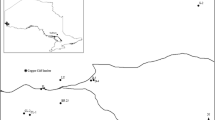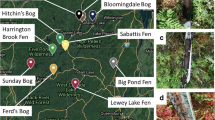Abstract
Microbial diversity, numbers, and metabolic activities in Minnesota peatlands were investigated using a variety of microbial enrichment and enumeration procedures together with radioisotopic measurements of microbial degradative processes. Minnesota peatlands were shown to contain large microbial populations of wide metabolic diversity. Direct counts of bacteria using epifluorescence microscopy indicated bacterial populations of about 108 ml−1 of peatland water, irrespective of depth. Radioisotopic most-probable-number (MPN) counts of heterotrophs able to mineralize14C-labeled substrates to14CO2 showed significant populations of glucose degraders (104–106 ml−1) as well as degraders of benzoate (102–103 ml−1), 2,4-dichlorophenoxyacetate (102–105 ml−1), and sphagnum (103–107 ml−1) in the various peatlands examined. The MPNs of NO3 − reducers varied from 103–106 ml−1, SO4 − reducers from 102–103 ml−1, methanogenic bacteria from 103–106 ml−1, and methane oxidizers from 103–104 ml−1, depending on sampling site and depth. Eighty pure cultures of aerobic bacteria and fungi were isolated from Minnesota peats. Most of those cultures tested were able to grow on at least 20 organic compounds (carbohydrates, aromatic molecules, hydrocarbons, etc.) as sole sources of carbon and energy. One isolate, aBacillus, was able to fix atmospheric N2. Several of the isolates were able to mineralize14C-labeled lignin.
Similar content being viewed by others
References
Alexander M (1965) Most-probable-number method for microbial populations. In: Black CA (ed) Methods in soil analysis II. American Society of Agronomy, Inc., Madison, Wisconsin, pp 1467–1472
Balch WE, Fox GE, Magrum LJ, Woese CR, Wolfe RS (1979) Methanogens: reevaluation of a unique biological group. Microbiol Rev 43:260–296
Balch WE, Wolfe RS (1976) New approach to the cultivation of methanogenic bacteria: 2-mercaptoethanesulfonic acid (HS-CoM)-dependent growth ofMethanobacterium ruminantium in a pressurized atmosphere. Appl Environ Microbiol 32:781–791
Burke ME, Gorham E, Pratt DC (1974) Distribution of purple photosynthetic bacteria in wetland and woodland habitats of central and northern Minnesota. J Bacteriol 117:826–833
Butlin KR, Adams ME, Thomas M (1949) The isolation and cultivation of sulfate reducing bacteria. J Gen Microbiol 3:46–59
Christensen PJ, Cook FD (1970) The microbiology of Alberta muskeg. Can J Soil Sci 50:171–178
Crawford DL, Crawford RL (1976) Microbial degradation of lignincellullose: the lignin component. Appl Environ Microbiol 31:714–717
Crawford RL (1981) Lignin biodegradation and transformation. Wiley-Interscience, New York
Dagley S (1977) Microbial degradation of organic compounds in the biosphere. Survey of Progress in Chemistry 8:121–170. Academic Press, New York
Daley RJ (1979) Direct epiflourescence enumeration of native aquatic bacteria: uses, limitations, and comparative accuracy. In: Costerton JW, Colwell RR (eds), Native aquatic bacteria: enumerations, activity, and ecology. American Society for Testing and Materials, Philadelphia, pp 29–45
Given PH, Dickinson CH (1975) Biochemistry, microbiology of peats. In: Paul EA, McLaren AD (eds) Soil biochemistry Vol. 3. Marcel Dekker, New York, pp 123–212
Gordon RE, Haynes WC, Hor-Nay Pang C (1973) The genus Bacillus. U.S. Government Printing Office, Washington. (stock #0100-2609).
Hanson RS (1980) Ecology and diversity of methylotrophic organisms. Adv Appl Microbiol 26:3–39
Hobbie JE (1979) Activity and bacterial biomass. Arch Hydrobiol Beih Ergebn Limnol 12:59–63
Hobbie JE, Daley RJ, Jasper S (1977) Use of nuclepore filters for counting bacteria by fluorescence microscopy. Appl Environ Microbiol 33:1225–1228
Ishizawa S, Araragi M (1970) Actinomycete flora of Japanese soils. Soil Sci and Plant Nutr 16:110–120
Kuster E, Locci R (1964) Studies on peat and peat microorganisms II. Occurrence of thermophilic fungi in peat. Arch für Mikrobiologie 48:319–324
Latter PM, Craig JB, Heal OW (1967) Comparative studies on the microbiology of four moorland soils in the northern pennines. J Ecol 55:445–464
Lehmicke LG, Williams RT, Crawford RL (1979)14C-most-probable-number method for enumeration of active heterotrophic microorganisms in natural waters. Appl Environ Microbiol 38:644–649
Moore JJ (1954) Some observations on the microflora of two peat profiles in the Dublin Mountains. Scient Proc RDS 26:379–395
Novitsky JA, Morita RY (1977) Survival of a pyschrophilic marine vibrio under long-term nutrient starvation. Appl Environ Microbiol 33:635–641
Patriquin DG, Knowles R (1974) Denitrifying bacteria in some shallow-water marine sediments: enumeration and gas production. Can J Microbiol 20:1037–1041
Rodina AG (1972) Methods in aquatic microbiology. University Park Press, Baltimore
Stanier RY, Palleroni NJ, Doudoroff M (1966) The aerobic pseudomonads: a taxonomic study. J Gen Microbiol 43:159–271
Stevensons LH (1978) A case for bacteria dormancy in aquatic systems. Microb Ecol 4:127–133
Stewart WDP, Fitzgerald GP, Burris RH (1967)In situ studies on nitrogen fixation using the acetylene reduction technique. Proc Nat Acad Sci USA 58:2071–2078
Visser SA (1964) The presence of micro-organisms in various strata of deep tropical peat deposits. Life Sciences 3:1061–1065
Waksman SA, Purvis ER (1932) The microbiological population of peat. Soil Science 34:95–113
Waksman SA, Stevens KR (1929) Contribution to the chemical composition of peat. V. The role of microorganisms in peat formation and decomposition. Soil Sci 28:315–339
Wang CH, Willis DL, Loveland WD (1975) Radiotracer methodology in the biological, environmental, and physical sciences. Prentice-Hall, Englewood Cliffs, New Jersey
Wheatley RE, Greaves MP, Inkson RHE (1976) The aerobic bacterial flora of a raised bog. Soil Biol Biochem 8:453–460
Williams RT (1982) Microbial aspects of carbon cycling in peatlands. PhD Thesis, University of Minnesota, Minneapolis
Ziemenko TG, Muchuk AT (1970) Effect of ground-water level on ammonification and nitrification in peat bog soils. Mikrobiologiya 39:522–526
Author information
Authors and Affiliations
Rights and permissions
About this article
Cite this article
Williams, R.T., Crawford, R.L. Microbial diversity of Minnesota peatlands. Microb Ecol 9, 201–214 (1983). https://doi.org/10.1007/BF02097737
Issue Date:
DOI: https://doi.org/10.1007/BF02097737




